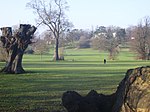Southcote Lock
1723 establishments in EnglandBerkshire building and structure stubsBuildings and structures completed in 1723Locks of Reading, BerkshireLocks on the Kennet and Avon Canal ... and 1 more
Use British English from February 2017

Southcote Lock is a lock on the River Kennet at Southcote near the town of Reading in Berkshire, England. It has a rise/fall of 5 feet 3 inches (1.60 m).
Excerpt from the Wikipedia article Southcote Lock (License: CC BY-SA 3.0, Authors, Images).Southcote Lock
Southcote Lock Footbridge, Reading Southcote
Geographical coordinates (GPS) Address Nearby Places Show on map
Geographical coordinates (GPS)
| Latitude | Longitude |
|---|---|
| N 51.436001 ° | E -1.004513 ° |
Address
Southcote Lock Footbridge
Southcote Lock Footbridge
RG30 3HJ Reading, Southcote
England, United Kingdom
Open on Google Maps








